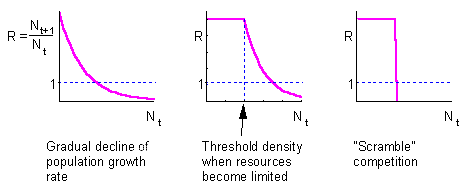11.1. Intra-specific competition
Intraspecific competition results in a reduction of population growth rate as population density increases. We already studied several models that consider intraspecific competition: logistic model and Ricker's model. In these models population growth rate steadily declines with increasing population density.However, in nature competition effect may be completely absent until population density reaches some threshold at which resources become limited.

Forest insect defoliators often have a "scramble" competition. If larvae can find foliage they still survive, but when all foliage is destroyed then mortality increases very rapidly. This is because these insects have seasonally-synchronized life cycles. If food is exhausted before they can pupate, then none of them pupates.
Mechanisms of competition:
- Simultaneous resource utilization. Examples: forest defoliators, dung insects
- Direct interaction. Examples: aggression, cannibalism, territoriality
Direct interaction among organisms makes competition balanced and usually results in a gradual decline of population growth rate with the decrease in the amount of resources.


